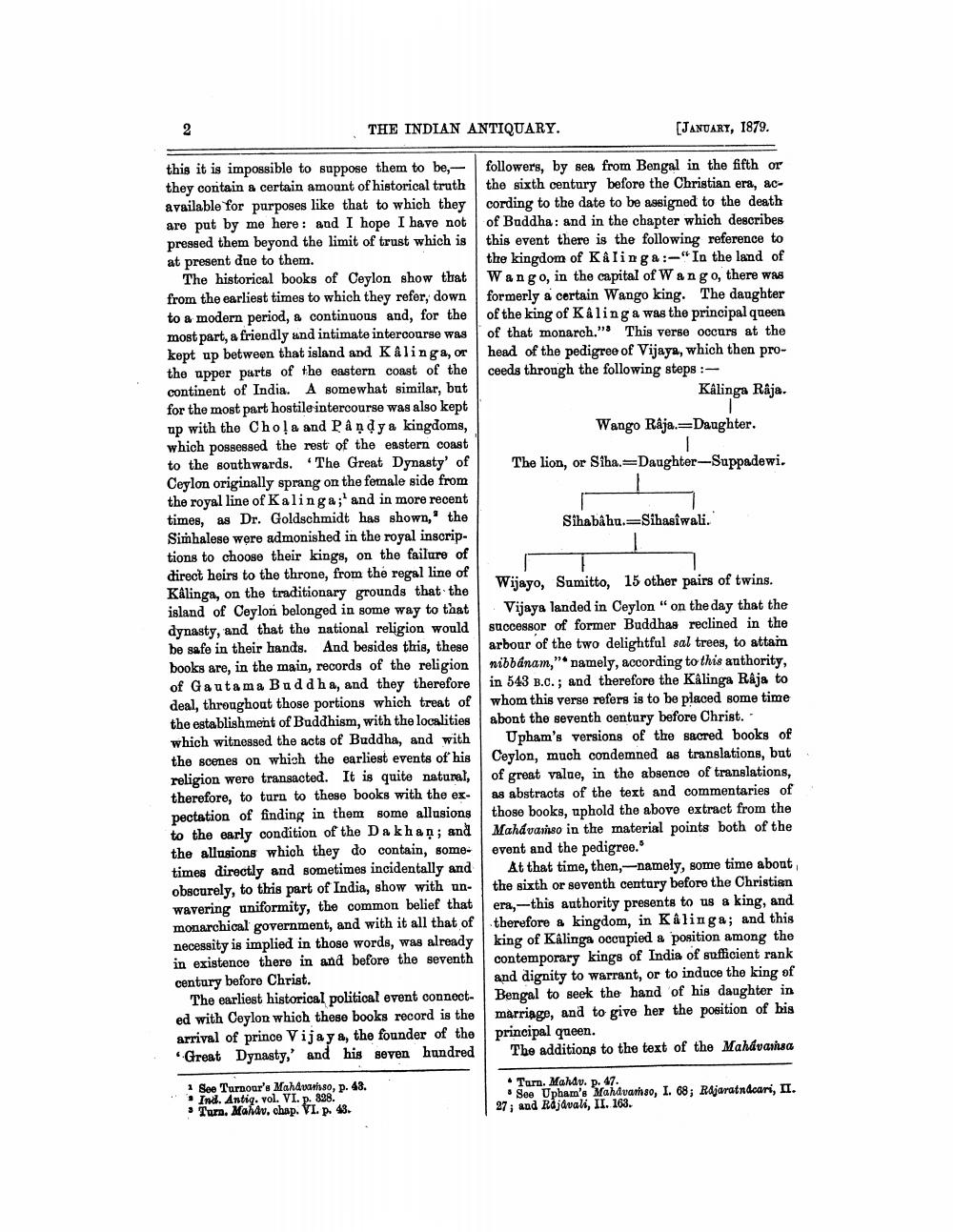________________
THE INDIAN ANTIQUARY.
[JANUARY, 1879.
this it is impossible to suppose them to be, followers, by sea from Bengal in the fifth or they contain a certain amount of historical truth the sixth century before the Christian era, acavailable for purposes like that to which they cording to the date to be assigned to the death are put by me here : and I hope I have not of Buddha: and in the chapter which describes pressed them beyond the limit of trust which is this event there is the following reference to at present due to them.
the kingdom of Kalinga :-"In the land of The historical books of Ceylon show that Wango, in the capital of Wango, there was from the earliest times to which they refer, down formerly a certain Wango king. The daughter to a modern period, a continuous and, for the of the king of Kalinga was the principal queen most part, a friendly and intimate intercourse was of that monarch." This verse occurs at the kept up between that island and Kalinga, or head of the pedigree of Vijaya, which then prothe upper parts of the eastern coast of the ceeds through the following steps :continent of India. A somewhat similar, but
Kalinga Raja. for the most part hostileintercourse was also kept up with the Chola and Pandya kingdoms,
Wango Rája.=Daughter. which possessed the rest of the eastern coast to the southwards. The Great Dynasty' of The lion, or Siha.=Daughter-Suppadewi. Ceylon originally sprang on the female side from the royal line of Kalinga;' and in more recent times, as Dr. Goldschmidt has shown,' the
Sihabahu.=Sihasiwali. Sinhalese were admonished in the royal inscriptions to choose their kings, on the failure of direct heirs to the throne, from the regal line of KÄlinga, on the traditionary grounds that the
Wijayo, Sumitto, 15 other pairs of twins. island of Ceylon belonged in some way to that Vijaya landed in Ceylon " on the day that the dynasty, and that the national religion would successor of former Buddhas reclined in the be safe in their hands. And besides this, these arbour of the two delightful sal trees, to attain books are, in the main, records of the religion nibbanam," namely, according to this authority, of Gautama Buddha, and they therefore in 543 B.C.; and therefore the Kalinga Raja to deal, throughout those portions which treat of whom this verse refers is to be placed some time the establishment of Buddhism, with the localities abont the seventh century before Christ. which witnessed the acts of Buddha, and with Upham's versions of the sacred books of the scenes on which the earliest events of his | Ceylon, much condemned as translations, but religion were transacted. It is quite natural, of great value, in the absence of translations, therefore, to turn to these books with the ex- as abstracts of the text and commentaries of pectation of finding in them some allusions those books, uphold the above extract from the to the early condition of the Dakha; and Mahávanso in the material points both of the the allusions which they do contain, some- event and the pedigree. times directly and sometimes incidentally and At that time, then, -namely, some time about obscurely, to this part of India, show with un- the sixth or soventh century before the Christian wavering uniformity, the common belief that era, ---this authority presents to us a king, and monarchical government, and with it all that of therefore a kingdom, in Kalinga; and this necessity is implied in those words, was already king of Kalinga occupied a position among the in existence there in and before the seventh contemporary kings of India of sufficient rank century before Christ.
and dignity to warrant, or to induce the king of The earliest historical political event connect- Bengal to seek the hand of his daughter in ed with Ceylon which these books record is the marriage, and to give her the position of bis arrival of prince Vijaya, the founder of the principal queen. Great Dynasty,' and his seven hundred | The additions to the text of the Mahavainsa
1 See Turnour's Mahdwanso, p. 43.
Ind. Antiq. vol. VI. p. 828. • Turn. Mahav, chap. VI. p. 43.
• Tarn. Mahdv. p. 47.
. See Upham's Mahavarso, I. 68; Rajaratndcari, II. 27; and Rājávali, II. 163.




